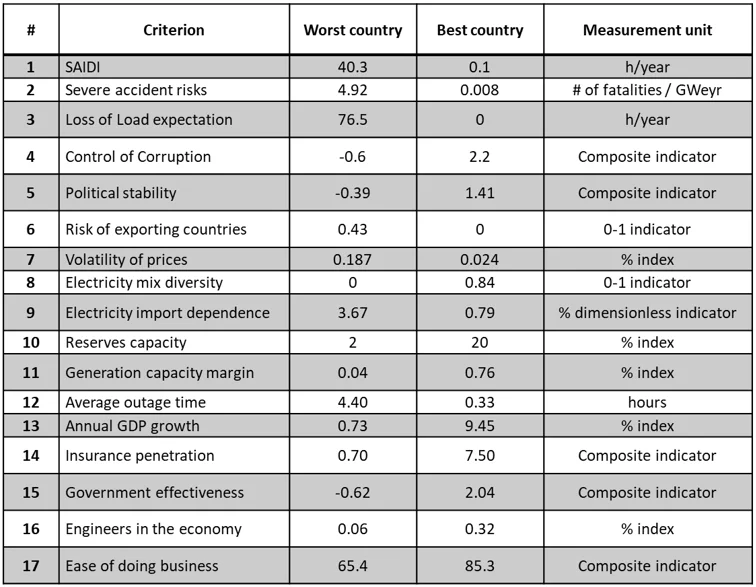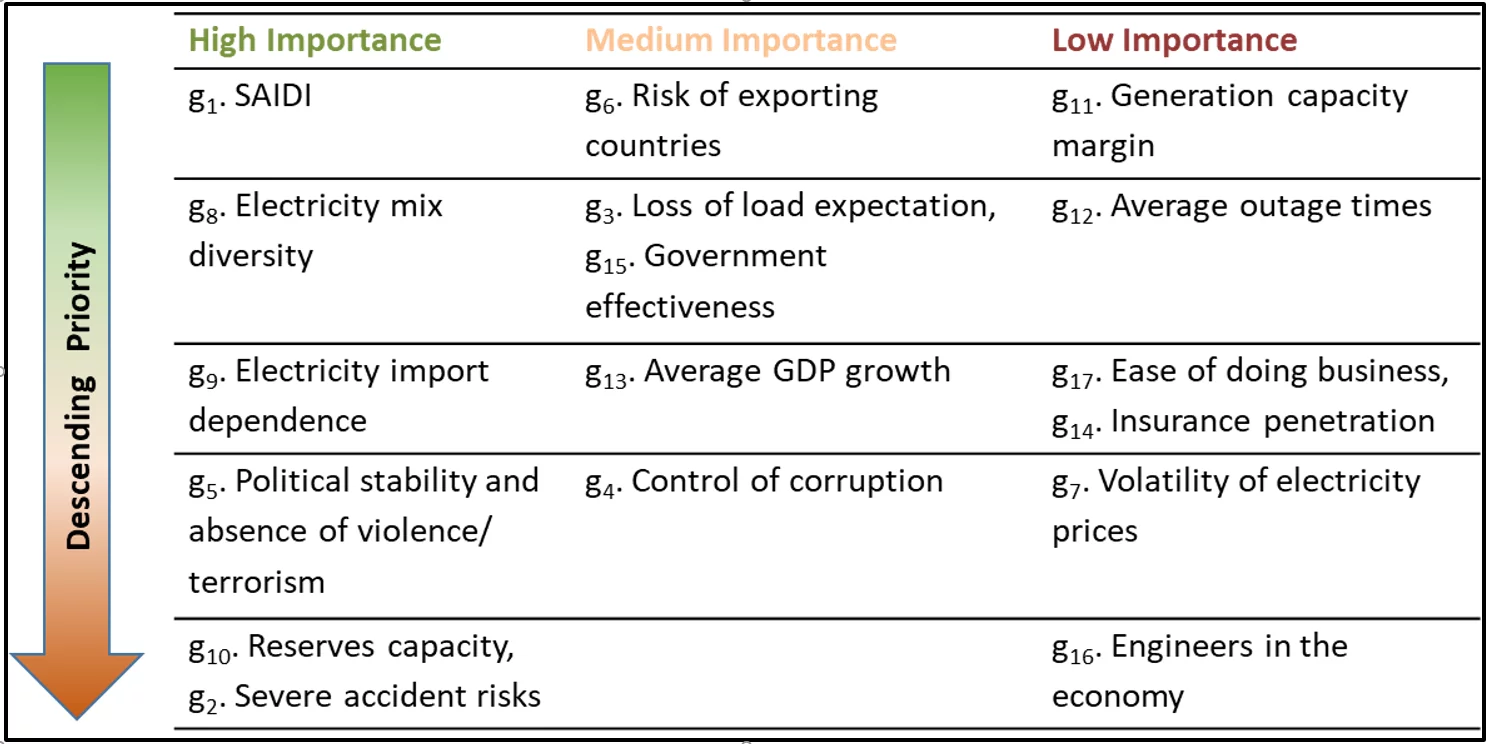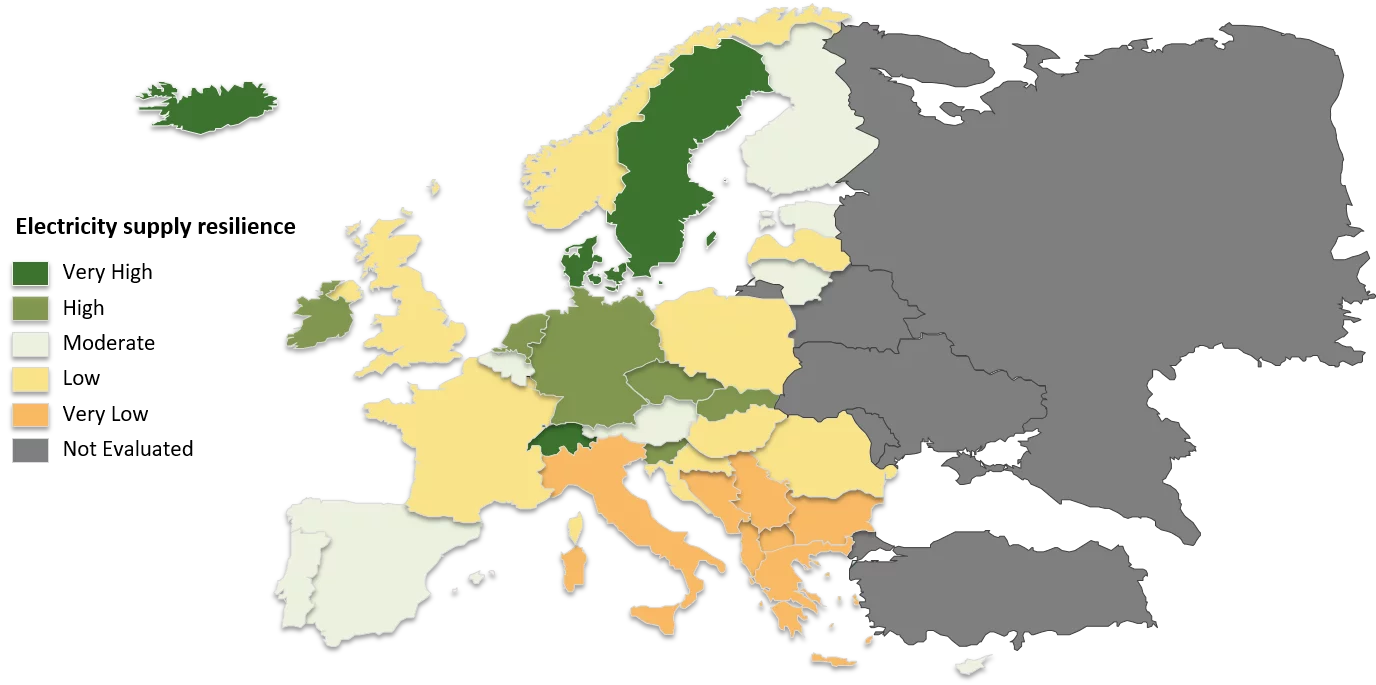Sustaining the resilience of the energy supply and safeguarding energy security are of paramount importance for energy policy making (IEA, 2020), especially in the current European context. A cornerstone to achieve these goals is to measure and assess the resilience status at a country level in a tangible and comprehensive manner. In this direction, we develop and implement a multi-criteria evaluation system for the resilience of electricity supply in Europe, based on the three major resilience dimensions of “Resist”, “Restabilise” and “Recover” (see Figure 1).
We evaluate and rank the 35 countries of the European Network of Transmission System Operators for Electricity (ENTSO-E), based on their performance on 17 evaluation criteria, which are summarized in Figure 2. The country data on the criteria are extracted from reliable databases, referring mostly to the year of 2020, and further processed and tailored according to the needs of the study.
Due to its significant size and the intricate and heterogeneous nature of the criteria, the evaluation system requires a carefully designed and adapted methodological framework, which in this case is based on a synergy of Multicriteria Decision Analysis (MCDA) methods (Greco et al. 2016). These include: (i) the method of the cards for the prioritization of the criteria (Siskos and Tsotsolas, 2015); (ii) certain newly-proposed heuristics for the identification and quantification of the potential negative or positive interactions between the criteria; and (iii) the Choquet integral value system for the assignment of a resilience score to each country (Grabisch and Roubens, 2000). The framework adds to the whole assessment the subjective nature of the preferences of a decision maker (DM), highly knowledgeable of the European energy system.
The elicitation of the preference information of the DM, according to the protocol of the method of the cards brought the hierarchy and categorization outcomes, summarized in Figure 3. This hierarchy, translated into a system of mathematical inequalities, allowed the analyst to calculate the importance weights of the criteria.
In the next phase, the DM identified five negatively and three positively interacting pairs of criteria (exhibiting redundancy or synergy between them, respectively). The DM also provided some additional information on the intensity of these interactions, helping therefore the analyst to quantify them.
The implementation of the Choquet integral function, based on the complete input elicited by the DM in the previous phases, led to the evaluation results, visualized in a classification format on the European resilience map in Figure 4.
As a conclusion, it is evident that the personalized evaluation results and the individual country scores should not be interpreted in a narrow perspective, but rather analyzed as part of a feedback loop on the raw indicator data and the actual subjective preferences of the DM. These help further understanding a country’s performance and subsequently focusing on identifying the weak points and the potential measures for improvement. Such analyses can have a significant practical impact, both political and economic, by influencing the development of initiatives and policies, targeting the fortification of the electricity infrastructures, and attracting considerable interest from a variety of stakeholders as well as governmental bodies.
This work offers certain interesting perspectives for future research, which we are currently studying in the TA Group of the LEA. Specifically, we are building and testing a coalition between the methodology presented here and a robustness analysis framework, in order to address the adverse effects of the former on the stability of the model results. We are coupling this framework with a newly developed preference elicitation algorithm and testing it on the topical, yet challenging, problem of energy security evaluation.
Author
Dr. Eleftherios Siskos
eleftherios.siskos@psi.ch
phone: +41 56 310 50 19
Laboratory Energy Systems Analysis, LEA
Technology Assessment Group
Dr. Peter Burgherr
peter.burgherr@psi.ch
phone: +41 56 310 26 49
Laboratory Energy Systems Analysis, LEA
Head of Technology Assessment Group
Original Publication
International Energy Agency (2020). Power systems in transition, Challenges and opportunities ahead for electricity security, Retrieved December 15, 2022 from https://www.iea.org/reports/power-systems-in-transition
Grabisch, M., Roubens, M. (2000). Application of the Choquet integral in multicriteria decision making, Fuzzy Measures and Integrals, pp. 348-374.
Greco, S., Ehrgott, M., Figueira, J., Eds. (2016). Multiple Criteria Decision Analysis: State of the art surveys, Second Edition, Volumes 1 & 2, Springer, New York.
Siskos, E., Tsotsolas, N. (2015). Elicitation of criteria importance weights through the Simos method: A robustness concern, European Journal of Operational Research, 246(2), pp. 543-553.
DORA ID: 38979
https://www.dora.lib4ri.ch/psi/islandora/object/psi%3A38979




